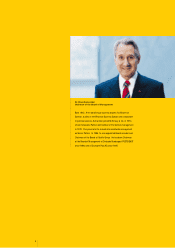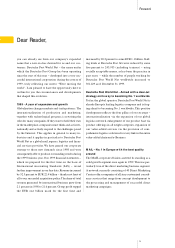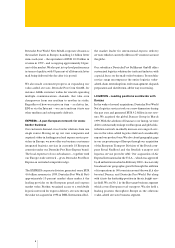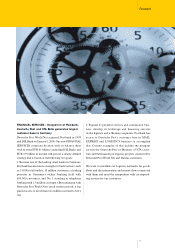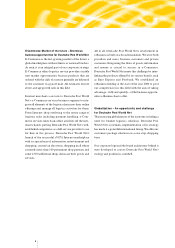DHL 1999 Annual Report Download - page 16
Download and view the complete annual report
Please find page 16 of the 1999 DHL annual report below. You can navigate through the pages in the report by either clicking on the pages listed below, or by using the keyword search tool below to find specific information within the annual report.
2. Markets in the midst of dramatic change
The mail,logistics and financial markets continued to see
vigorous change in 1999.Liberalization,globalization and
technological change arising primarily in the wake of the
e-Commerce revolution are in full swing and will change
the markets dramatically for us and our customers.
2.1. Changes in the marketplace
The rapid, worldwide availability of information
through the Internet, in conjunction with the progres-
sive elimination of trade barriers, such as within the
European Union - will substantially accelerate the inter-
nationalization of information, goods and services.
Customers increasingly demand package solutions for
the physical execution of these activities, solutions that
do not stop at national borders or weight limits and
come in conjunction with value-added services,all from
a single source.
Four core trends underlie these changes in the logistics
markets:
• Internationalization
• Broad range of products, one-stop-shopping
• Provision of value-added services from a single source
• E-Commerce revolution
Internationalization
Large companies and a growing number of small and
medium-sized firms in all sectors are seizing the opportu-
nity offered by the European Monetary Union, the Single
European Market and the liberalization of markets
around the world to internationalize their business. This
is generating a growing need for seamless, cross-border
services. Studies conducted by the Center for Logistics
and Corporate Planning at the Technical University of
Berlin in January 2000 confirm this trend.According to
these studies, onethird of all commodity flows are
already globally distributed today. This figure was
approximately 20 percent in 1995.
15
Management Report
Single-source value-added services
The worldwide trend toward outsourcing is gaining
momentum because trade and industry have to make
use of every opportunity available to cut costs. Accord-
ing to studies conducted by the Institute for Technology
and Management at the Technical University of Berlin,
outsourcing logistics services remains one of the pre-
ferred methods for reducing operating costs. European
companies are expected to follow this trend in growing
numbers over the next several years.In the process,they
will close the gap that exists between them and Ameri-
can companies in the levels of logistics services being
outsourced.
One third of all commodity flows are distributed
globally
This trend is expected to continue.We believe that it will
demand efficient, international network logistics with
fast-growing capacity.
U.S.A.: ➞
Continental 74 %
EU 8 %
South America
5.5 %
Asia 7%
Eastern Europe
1%
Europe: ➞
Continental 76 %
NAFTA 14%
Asia 4 %
Eastern Europe
2.5 %
South America
2.5 %
Tigers: ➞
Continental 64 %
EU 15 %
NAFTA 11 %
South America
1%
Eastern Europe
1%
Japan: ➞
Continental 65 %
EU 15 %
NAFTA 15 %
South America
1%
Source: The Next Wave of Logistics:
Global Supply Chain Efficiency, Berlin/Boste, 1999, TU Berlin
Percentage of goods (based on value)
going to the following regions:



